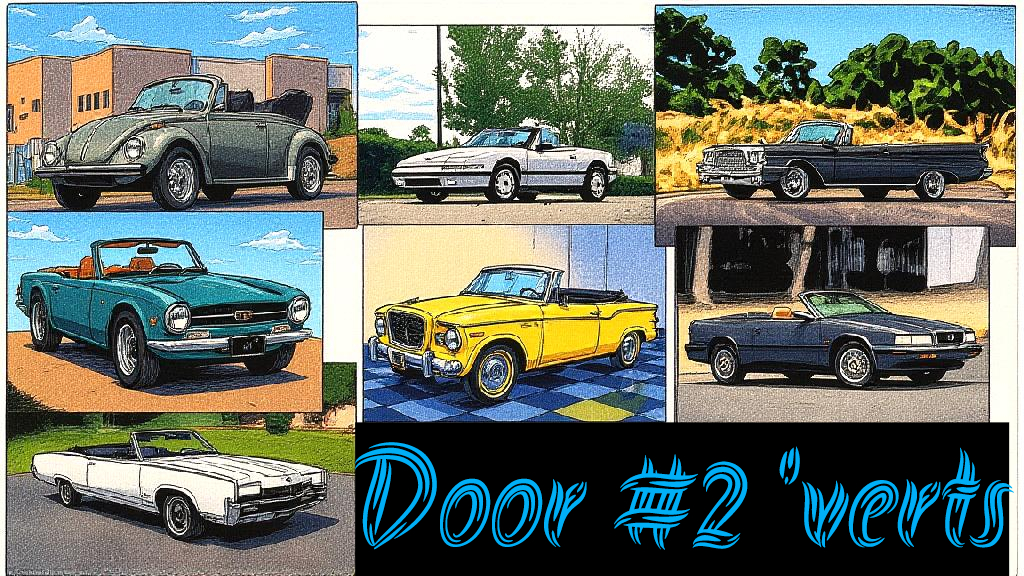The convertible has always been the unconventional cousin in the automotive family.
There are many reasons for that label, but practicality is number one on the list.
Despite their non-practical nature, convertibles have always played a big role in the car guy world, so here are a few examples of cool ‘verts from 1960-1990.
Jerry Sutherland
These examples all represent two less popular, door number two convertibles from the start of every decade, so there’s a ten-year gap between the examples. That gap is important.
The 1960 Studebaker Lark convertible wasn’t at the top of everyone’s list that year, but it did have its own built-in appeal. Size was a factor because the Lark was already in the game when the compact car became a factor in the early 60s nuclear family.
Two-car families sprung up overnight in 1960 and the Lark was the perfect choice for a second car. Maybe not a convertible Lark, but the fuel economy justified a frivolous purchase.
The 1960 DeSoto convertible was another story. This car was a bridge between the finned 50s and the space age 1960s.
DeSoto was in its second last year of existence, but it exited with one of the coolest fin car convertibles ever made. It wasn’t like the Lark–a ’60 DeSoto convertible was light years away from practical—but it’s an historical piece of automotive art in 2025.
1970 was the beginning of the end for convertibles in North America, but the Triumph TR6 was in its second year in ‘70.
It carried on the traditional British sports car tradition with an updated flair, so the TR6 swam upstream in the dying days of roofless cars. The TR6 did come with an optional hardtop, so Triumph had its bases covered when convertible sales were losing altitude fast in 1970.
The 1970 Mercury Marquis convertible was a great example of what a typical land yacht droptop looked like at the start of the Me Decade. These Mercs were massive barges with brutal gas mileage–a few scant years before OPEC held the world hostage at the gas pumps.
Governments worked against carmakers at the other end with massive overkill in smog and bumper laws. It didn’t matter to the guy who bought a ’70 Marquis convertible because he was clearly cutting his own swath in life.
The convertible buyer didn’t have many options in 1980, but the ’80 Super Beetle convertible was a solid fallback position.
The droptop VW convertible rode into the sunset in 1980. In fact, they were ’79 Beetles with 1980 registration status because of upcoming laws that rendered them obsolete–VW only sold 4572 of them in 1980. Nevertheless, they were real convertibles.
Car buyers who only bought domestic iron had to buy “coach-built” (custom-fabbed) convertibles because Detroit quit building them in 1976.
The 1980 Cadillac Eldorado convertible was built by subcontractors Hess and Eisenhardt to fill the gap. These cars were so naturally cool the question was simple—why did Caddy quit building classy droptops?
1990 was a far more receptive year for convertibles—the 1990 Buick Reatta is a shining example. The Reatta was lucky because it debuted in the 1990, so it fought regulations with technology.
They came with a 3.8-liter V-6 that pumped out a respectable 175 horsepower. They weren’t lightning fast, but the mileage and handling made up for it—plus it was a Buick, so it was a big step above a Chevy Sprint.
The last convertible is the 1990 Maserati TC (touring convertible). This was a co-production between Chrysler and Maserati, and it came with an optional 200-horse 2.2 liter, 16-valve, turbocharged, Maserati 4-cylinder complete with a Getrag 5-speed manual.
They only sold 500 of the Mase-ryslers, but their existence speaks volumes about the new 90s attitude about convertibles.
The bottom line? Convertibles never went away, so the world’s still a droptop paradise.
Jerry Sutherand
By: Jerry Sutherland
Jerry Sutherland is a veteran automotive writer with a primary focus on the collector car hobby. His work has been published in many outlets and publications, including the National Post, Calgary Herald, Edmonton Journal, Ottawa Citizen, Montreal Gazette, Saskatoon StarPhoenix, Regina Leader-Post, Vancouver Sun and The Truth About Cars. He is also a regular contributor to Auto Roundup Publications.
- CLICK HERE TO SIGN UP FOR THE NEWSLETTER
- CLICK HERE to Like us on Facebook
- CLICK HERE to Follow us on Twitter
- CLICK HERE to Follow us on Pinterest
